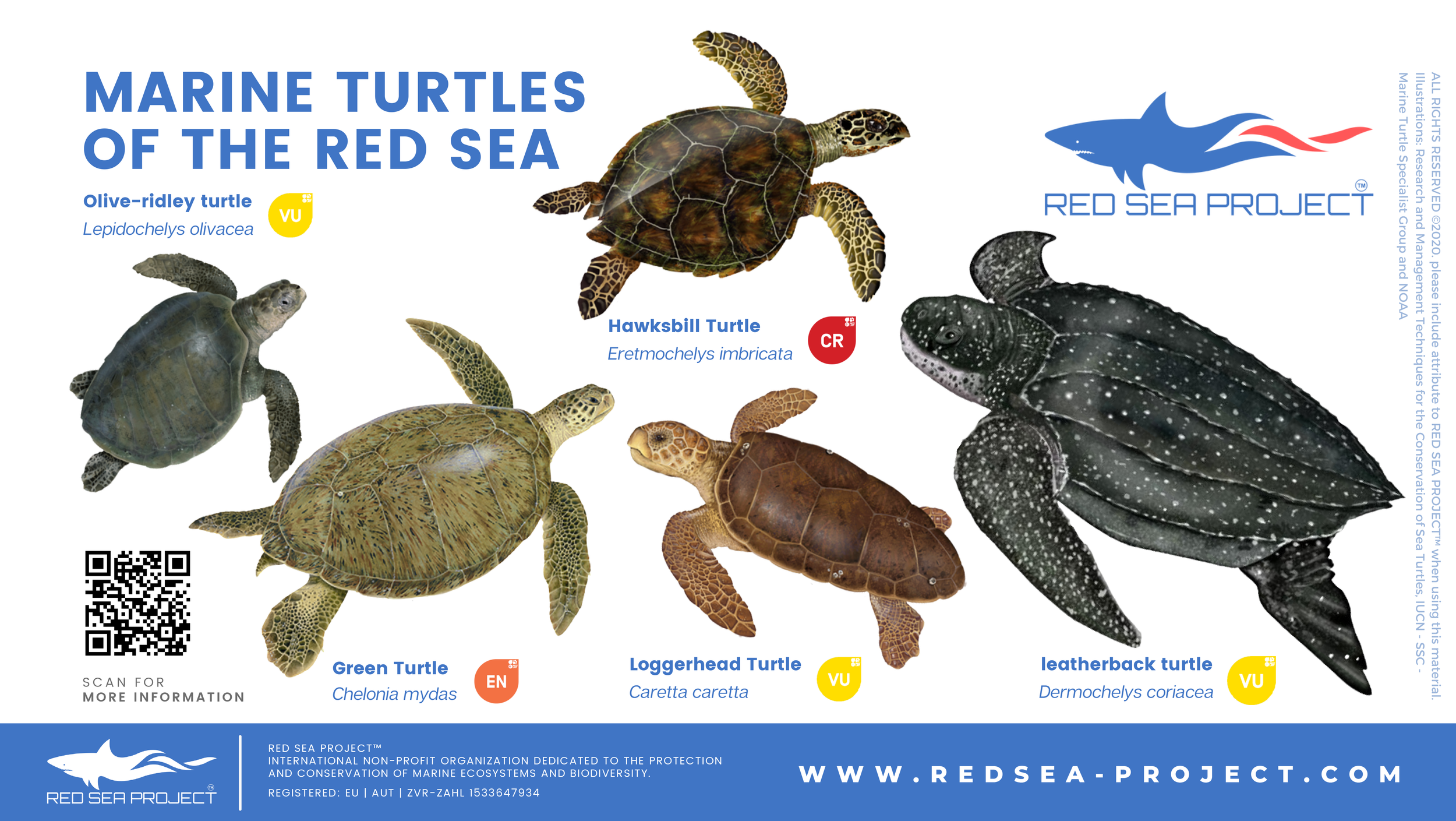Red Sea Turtles - Kids Edition
Who are they and how do we identify them?
Reptiles - Cheloniidae < Cheloni, χελώνη, ης (ἡ) - turtle
5 different species of sea turtles in the Red Sea
The green turtle
The hawksbill turtle
The leatherback turtle
The olive-ridley turtle
The loggerhead turtle
The top part of the turtle is what we call the shell, while the bottom part covering the belly is called the plastron.
The size, weight and maturity age range can vary significantly from one species to the other; olive-ridleys are the smallest, and leatherbacks are the biggest, reaching up to 180 cm!
Cold-blooded animals, turtles live in warm waters
YES:
They know how to instinctively take advantage of currents; sensitive to the magnetic field, they use it as a compass (it is called magneto-reception)
They can slow down their heartbeat to conserve energy!
While sleeping they can stay up to 7 hours without having to come up to the surface to breathe. They rest either on the sea surface, or at the bottom under rocks
NO:
Contrary to tortoises, sea turtles can't hide in their shells.
But their oval and smooth shape help them move around more easily in their environment
Life cycle and diet
The turtle eggs begin to hatch after 6 to 10 weeks - Hatchlings use a temporary tooth-like outgrowth called caruncle to break the shell (it falls off soon after hatching)
Then the baby turtles wait until the evening to start their journey: predators are fewer, and the sand is not so hot
The reflection of the moon on the sea guides them to the water
But when they reach the sea the very young turtles are still largely exposed to danger
Turtles take 20 to 30 years to reach full maturity; at that time, they move from oceanic to coastal habitats
Once they reach adulthood, turtles return to the deep ocean for reproduction and migrate (up to 10,000 km - sometimes during several months) to the beach where they were born (natal-homing). But leatherbacks and olive ridleys spend both developmental and adult stages in oceanic zone
After the mating season, females go to the beach of their birth; males return to the area where they usually feed
Hatchlings are omnivores but turtles mostly eat algae, seagrass, jellyfish, sponge, shrimp, crabs, and mollusks. The loggerhead turtle eats almost exclusively jellyfish, while the hawksbill turtle subsists primarily on sponges. Sea turtle mouths and jaws are shaped differently depending on their particular diet
Reproduction
From April to October: it varies according to the types of turtles
The reproduction ritual has been identical for millions of years
After mating in the open sea, off the nesting beach, female turtles return to the beach shore to lay the eggs, at night
Males fertilize several females, and the same female can be fertilized by several males
A turtle lays eggs every 2 to 4 years; she buries her eggs in the sand before returning to the sea
Females will be able to make 2 -7 nests per season (about one every 10 -15 days)
Digging the nest, laying eggs and camouflaging can take up to 3 hours; the whole process is exhausting
Only green and hawksbill turtles nest on the inland shores of the Red Sea; Tiran Island, Zabargad Island and Wadi Gemal-Hamata National Park are the main nesting sites
The sex of the turtles will depend on the temperature in the nest (warmer for females, cooler for males)
Their main role in the ecosystem
But why all this buzz about turtles all of a sudden?
Well, sea turtles are nearing extinction, yet they play a very important role in the sea’s delicate balance.
They do this by:
regulating the seagrass life.
NB.: Seagrasses are known as the "lungs of the sea" (1m2 of seagrass can generate 10l of oxygen every day through photosynthesis)
providing nutrients to our beaches and birds via their eggs.
reducing the sea sponge’s population and therefore helping the development of coral reefs.
offering food to sharks, orcas, groupers, and other sea life which helps maintain the balance of our oceans.
What are their main threats
The destruction of their habitat
Bycatches
Pollution (oil spills affect them because they regularly come to the surface to breathe)
Hunt, mainly for their meat and shell and eggs collection
The ingestion of marine debris (plastic bags mistaken for jellyfish among others)
Global warming: warmer beaches mean more females meanwhile rising waters involves that the landmarks are distorted, which confuses the turtles to return to the desired beach when laying eggs
They are protected by the international and national laws of most countries bordering the Red Sea, but their enforcement is substantially lacking. Furthermore, as the turtles’ habitat varies between beaches, coastal areas, and the high seas, the protection must go beyond territorial borders
Let’s put it in numbers
250 M years: they’ve existed on our planet and turtle’s mating rituals have stayed unchanged for the most part for the past couple million years
A turtle’s lifespan can range anywhere from 30 to 100 years
Turtles can choose a habitat up to 10,000 km away from the beach where they were born
7 species of sea turtles live worldwide
5 of which can be found in the Red Sea; 3 species only are frequently observed in the Red Sea
5 of the turtles found in the Red Sea are classified as threatened by IUCN and 1 as critically endangered (the hawksbill turtle)
120 Green Turtles, at least, have their home in Marsa Abu Dabbab
Roughly 500 turtles have made the coast of the Red Sea their home
50 - 200 eggs per nest
About 1 egg out of 1000 will become an adult turtle
20m: the minimum distance that you should leave between you and the animal, if you ever see a turtle on a beach
2m, while snorkeling; 3m, while diving: No approach zone
30 min: Limited time to spend in proximity
Red Sea Project’s involvment
Marine turtles conservation programs
Fun Fact: every marine biologist in Redsea Project has a turtle named after them!
Education
Educate yourself and raise awareness
Do not throw waste in the oceans, seas
Do not touch any living individuals or take them outside of their natural habitats
Observation
Observation and pictures WITHOUT the flash
Limited time spent in proximity: 30 min
No approach zone: 3 meters while diving and 2 meters while snorkeling
Conservation
Use photo-identification to help us protect and monitor turtles since it allows us to know where they are and therefore better protect them.
We need clear images of:
the right profile
the carapace
the left profile
To protect nesting sites:
No off-road driving, keep 20 meters distance, lights off,
use no flash so as not to disorient the turtle nor the hatchlings
Remain unnoticed behind the turtle - do not move it
Refer to the authorities in case of signs of distress
Sad to say: according to the IUCN red list, all the sea turtles are now listed as
- critically endangered
- endangered
- or at least vulnerable
And last but not least, the volunteers of the Team 101, in partnership with Red Sea Project, have prepared a board game for you, which you’ll find by clicking on the following links: tokens, cards, game board and rules. Documents in PDF format are available for free and can be printed easily.
If you download that kit, consider making even a small donation to support Red Sea Project efforts to protect the environment.









